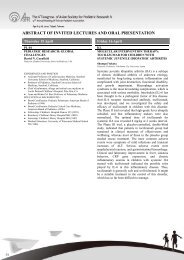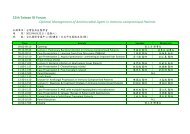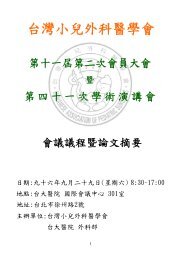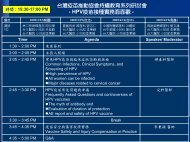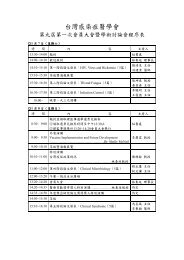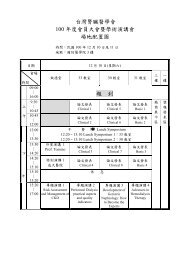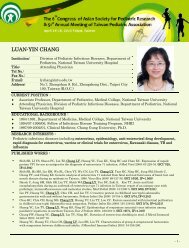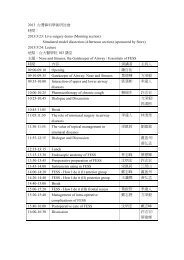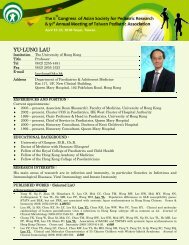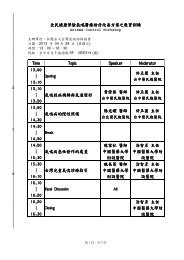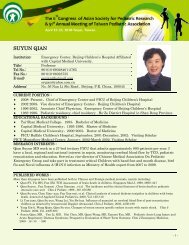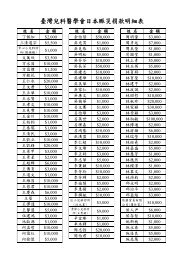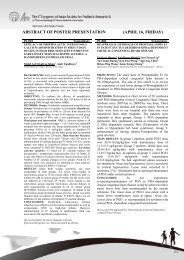ABSTRACT OF POSTER PRESENTATION (APRIL 17, SATURDAY)
ABSTRACT OF POSTER PRESENTATION (APRIL 17, SATURDAY)
ABSTRACT OF POSTER PRESENTATION (APRIL 17, SATURDAY)
You also want an ePaper? Increase the reach of your titles
YUMPU automatically turns print PDFs into web optimized ePapers that Google loves.
P2-063 Neuropsychiatry (Neurology) P2-064 Neuropsychiatry (Neurology)PREVALENCE <strong>OF</strong> PRESUMPTIVE READINGDISORDER AMONG GRADE TWOSTUDENTS IN PUBLIC SCHOOLS <strong>OF</strong>CLINICAL ANALYSIS <strong>OF</strong> PATIENTSSUSPECTED <strong>OF</strong> HAVING NOVEL INFLUENZA A(H1N1) ENCEPHALOPATHYDISTRICT 1 DASMARIÑAS, CAVITE ADESCRIPTIVE CROSS SECTIONAL STUDYJasmin Morales MarasiganPediatrics, DLSU HIS, PhilippinesHiroshi IDEGUCHI 1 , Yukiko IHARA 1 , Yuko TOMONOU 1 ,Takahito INOUE 1 , Sawa YASUMOTO 1 , Shinichi HIROSE 1Institution of First Author 1 , Institution of Second Author 2 , Institution of ThirdAuthor 3; Department of Pediatrics, Faculty of Medicine, Fukuoka University,Fukuoka, JapanBACKGROUND: Reading disorders are present inapproximately 75% of children and adolescents withlearning disorders. Prevalence studies find ratesranging between 2 to 8 percent. Students who havelearning problems in other academic areas mostcommonly experience difficulties with reading aswell. The child may become frustrated by thedifficulty in learning to read and other problems canarise which can jeopardize the child’s success in theschool and in the future. Moreover, readingdifficulties that are not intervened at by 8 year of agetend to persist.OBJECTIVE: To determine the prevalence ofpresumptive reading disorder among grade twostudents in public schools of District 1 Dasmarinas,Cavite.DESIGN: Cross-sectional descriptive study.SUBJECTS: Grade two students from 15 publicschools of District 1 Dasmarinas, Cavite.METHODOLOGY: Stratified random samplingwas used and twenty grade two students wererandomly selected from each 15 Public schools tocollate 300 sample size. The PediatricNeuropsychology Screening Examination on SingleWord Reading was used to screen the students forpresumptive reading disorder.OUTCOME MEASURES: Students who screenedhaving presumptive reading disorder.RESULTS: The prevalence of presumptive readingdisorder was 8.3% with a mean age of 7.84 + 1.248years, found higher among females at 56%.Associated difficulties in written language were alsoidentified.CONCLUSION: Presumptive reading disorder is ascommon among grade two students in public schoolsof Dasmarinas, Cavite as elsewhere. Hence, earlyscreening for all elementary students for readingdisorder is recommended.OBJECTIVES: Stating concisely why the study wasconducted. To analyze the clinical and neurologicalsymptoms and histories of patients who were suspectedof having novel influenza A (H1N1) encephalopathy.METHODS: An explanation of the study design andexperimental methods used From August to November2009, 19 children were admitted to Fukuoka UniversityHospital with suspected encephalopathy due to H1N1infection. The diagnosis of H1N1 infection was made bya rapid influenza test. Here, we investigate their clinicalsymptoms, previous histories, and final diagnoses.MAIN RESULTS: A concise summary of the majorfindings of the experiment or study. The 19 childrenranged from 3 to 12 years of age (average 8 years); 10were boys, 9 girls. Their clinical symptoms showedconsciousness disturbances and hallucinations (6),convulsive seizures and consciousness disturbances (5),convulsive seizures (3), consciousness disturbances (2),convulsive seizures and hallucinations (1),consciousness disturbances, hallucinations, and ataxia(1), hallucinations (1). Previous histories showed febrileconvulsion (6), bronchial asthma (2), acuteencephalopathy (1), and epilepsy (1). Before admission,oseltamivir was given to 8 of the patients, rimantadine to6, and 5 received nothing. We treated withmethylprednisolone pulse therapy 3 children who, onadmission, had high amplitude slowed wave EEGs. In allcases, consciousness disturbances improved the day afteradmission. Our final diagnosis included complex febrileseizures (8), febrile delirium (7), acute cerebellar ataxiawith febrile delirium (1), influenza encephalopathy (1),epilepsy (1), and moyamoya disease (1).CONCLUSION: Summary of the overall findings andthe importance of the study. Patients with a history offebrile seizures are at risk for neurological complicationson H1N1 infection.[Keywords] Arial font, Bold, size 10,)novel influenza[Keywords]reading disorder, reading disabilities, dyslexia,primary school students286



